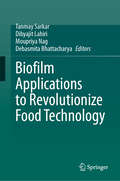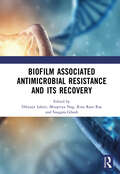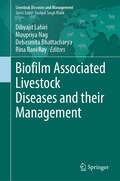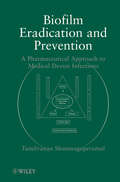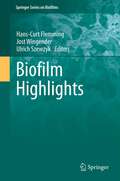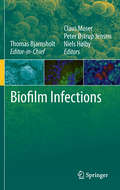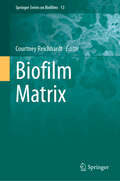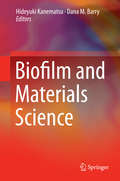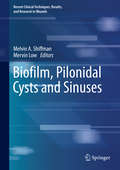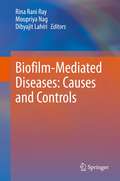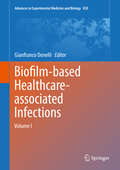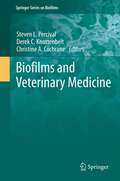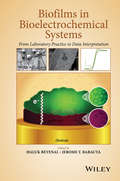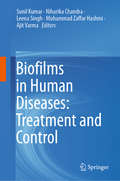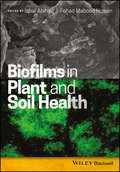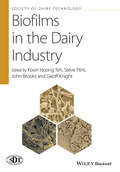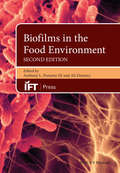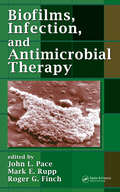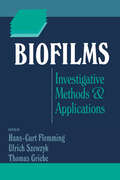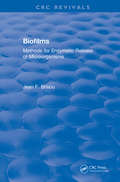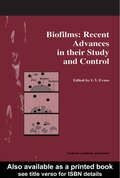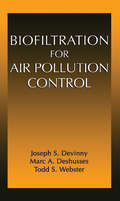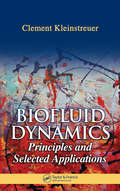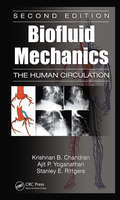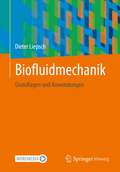- Table View
- List View
Biofilm Applications to Revolutionize Food Technology
by Moupriya Nag Dibyajit Lahiri Tanmay Sarkar Debasmita BhattacharyaBiofilm Applications to Transform the Food Industry is a sweeping introduction to the world of biofilms, illuminating their potential to revolutionize the landscape of both food safety and culinary innovation. This groundbreaking work delves into the various methods through which biofilms improve quality and sensory aspects, while also enhancing overall safety and sustainability. At its core, this book addresses the preeminent challenge facing the food industry: how to optimize taste, enhance safety and extend shelf life without compromising nutritional value. It offers a dynamic blueprint for chefs, food scientists, and industry professionals to leverage biofilm usage, exploring cutting-edge techniques that revolutionize fermentation, flavor enhancement, and waste reduction. By decoding the intricate mechanisms of biofilm interactions, this work unveils solutions to persistent industry challenges, providing practical insights and strategies to elevate culinary experiences while meeting consumer demands for healthier, safer, and more flavorful foods. Biofilm Applications to Transform the Food Industry is an indispensable guide for culinary professionals, food technologists, and enthusiasts seeking to stay ahead in a rapidly evolving industry. It equips readers with the tools to navigate the complexities of biofilm applications, empowering them to innovate, create ethically sound products, and contribute to a more sustainable future. This title's relevance lies in its ability to bridge the gap between cutting-edge science and practical culinary applications, making it an essential resource for those passionate about shaping the future of food technology.
Biofilm Associated Antimicrobial Resistance and Its Recovery
by Rina Rani Ray Moupriya Nag Dibyajit Lahiri Sougata GhoshA biofilm is a collection of microbial cells that have adhered to biotic surfaces such as plant cuticles or animal epithelia, as well as abiotic surfaces such as rocky substratum or catheter exteriors. The life cycle of a microorganism includes the fundamental process of biofilm formation for survival in diverse and harsh environments since it is a protected mode of growth allowing colonisation of new habitats by dispersal of microbes from the microbial clusters. The biofilm bound microorganisms remain embedded in an extracellular polymeric matrix that protects the indwelling cells from surfactants, biocides, several invaders like protozoans, and defences offered by the hosts like phagocytic cells. The biofilm bound recalcitrant microbes induce chronic and nosocomial diseases, posing a serious threat to public health. It has been observed that various antimicrobial drugs are able to successfully remove the planktonic (freely suspended) states of microbes as compared to the sessile (substrate-bound) forms, thus resulting in the development of antimicrobial resistance. Modern pharmacological strategies targeting the biofilm matrix differ from the conventional methods of antibiotic usage. This includes the use of natural compounds such as plant bioactive molecules, antimicrobial peptides, green synthesised nanoparticles, or secondary metabolites from other organisms that not only prevent the rise of antimicrobial resistance but are also safe for the host tissues. Biofilm Associated Antimicrobial Resistance and Its Recovery provides a detailed and systematic review of alternative pharmacological developments in the field of biofilm research. Features: A narrative overview of the mechanism of biofilm formation and its role in the emergence of antimicrobial resistance. Recent research in the development of antibiofilm remedies involving biogenic compounds. Advancements in biofilm detection methodologies with cutting-edge technologies. This book serves as a resource for researchers who need to understand and analyze the progression of events during microbial biofilm formation, as well as design safer methodologies for its successful eradication. It may also be used as a textbook for a graduate level course in microbiology or microbial biotechnology.
Biofilm Associated Livestock Diseases and their Management (Livestock Diseases and Management)
by Rina Rani Ray Moupriya Nag Dibyajit Lahiri Debasmita BhattacharyaThe book discusses biofilms and adherent communities of microorganisms that play a significant role in livestock-associated infections. It explores the characteristics, formation, and consequences of biofilms in various livestock species and explains their involvement in diseases like mastitis, Johne's disease, caseous lymphadenitis, and more. It also explains intricate aspects of biofilm-related challenges, such as virulence, antibiotic resistance, quorum sensing, and inter-species communication. The book then explores the strategies for combatting biofilm-associated infections, encompassing phytomedicines, novel antimicrobials, and nanomedicines. This book serves as a great resource for researchers, veterinary practitioners and students by addressing these critical issues and providing a comprehensive understanding of biofilm dynamics in livestock infections, fostering improved diagnosis and treatment methodologies.
Biofilm Eradication and Prevention
by Tamilvanan ShunmugaperumalBiofilm Eradication and Preventions presents the basics of biofilm formation on medical devices, diseases related to this formation, and approaches pharmaceutical researchers need to take to limit this problem. Split into three parts, the first deals with the development and characterization of biofilm on the surfaces of implanted or inserted medical devices. Questions as to why biofilms form over medical device surfaces and what triggers biofilm formation are addressed. In the second section, the author discusses biofilm-mediated chronic infections occurred in various organs (eyes, mouth, wounds) and pharmaceutical and drug delivery knowledge gained from research in these area. The third part explores pharmaceutical approaches like lipid-and polymer-based drug delivery carriers for eradicating biofilm on device-related infections. In addition, this section also explores the topic of novel small molecule (like iron and its complexes/metal chelators) and a quorum-sensing inhibitors to control medical biofilm formation.
Biofilm Highlights (Springer Series on Biofilms #5)
by Hans-Curt Flemming Jost Wingender Ulrich SzewzykLiving in biofilms is the common way of life of microorganisms, transiently immobilized in their matrix of extracellular polymeric substances (EPS), interacting in many ways and using the matrix as an external digestion and protection system. This is how they have organized their life in the environment, in the medical context and in technical systems - and has helped make them the oldest, most successful and ubiquitous form of life. In this book, hot spots in current biofilm research are presented in critical and sometimes provocative chapters. This serves a twofold purpose: to provide an overview and to inspire further discussions. Above all, the book seeks to stimulate lateral thinking.
Biofilm Infections
by Claus Moser Thomas Bjarnsholt Niels Høiby Peter Østrup JensenThis book will cover both the evidence for biofilms in many chronic bacterial infections as well as the problems facing these infections such as diagnostics and treatment regimes. A still increasing interest and emphasis on the sessile bacterial lifestyle biofilms has been seen since it was realized that that less than 0.1% of the total microbial biomass lives in the planktonic mode of growth. The term was coined in 1978 by Costerton et al. who defined the term biofilm for the first time.In 1993 the American Society for Microbiology (ASM) recognised that the biofilmmode of growth was relevant to microbiology. Lately many articles have been published on the clinical implications of bacterial biofilms. Both original articles and reviews concerning the biofilm problem are available.
Biofilm Matrix (Springer Series on Biofilms #13)
by Courtney ReichhardtThis book provides a comprehensive review of biofilm matrices. The main topics include an introduction to biofilm matrices and the range of biofilm matrix components (i.e., biofilm matrixome) as well as an overview of what is known about matrix structure, functionality, and regulation. Additional topics include recent progress in investigating the biofilm matrixome as well as challenges and outstanding questions and descriptions of the influence of matrix interactions on biofilm architecture and pathogen-host interactions. This book covers an important aspect of biofilm biology-microbial biofilm matrices. Microbes form multicellular aggregates called biofilms, in which microbial cells are encased in an extracellular matrix. This enables microbes to withstand harsh environmental conditions including antibiotic treatment. Biofilms are ubiquitous in the environment and can be both beneficial and harmful. For example, they can be used to clean up wastewater, but they also cause serious and chronic infections. It is estimated that over 80% of infections in the United States are biofilm-associated. Some examples of biofilm-involved infections include infections of implanted medical devices or artificial joints and also chronic infections of burns and wounds, including diabetic ulcers. When biofilms show up during infections or human health problems, they act very differently than planktonic bacteria. For example, biofilms can be ~1000-fold more tolerant of antibiotics than their planktonic counterparts. The biofilm matrix is thought to be a key part of why these bacterial infections are so difficult to treat. Biofilm matrix composition varies between bacterial strains and under different growth conditions. In general, the biofilm matrix is rich in biopolymers and can contain exopolysaccharides, proteins, extracellular DNA (or eDNA), and lipids. The biofilm matrix promotes attachment and structurally reinforces bacterial aggregates, preventing clearance by mechanical forces. The matrix can even block antibiotics from accessing the bacteria or prevent the host immune system from seeing the bacteria. The target audience of this book is both established biofilm researchers and those who are newly learning about biofilms and biofilm matrices.
Biofilm and Materials Science
by Hideyuki Kanematsu Dana M. BarryThis book explains the formation of biofilm on materials surfaces in an industrial setting. The authors describe new developments in understanding of biofilm formation, detection, and control from the viewpoint of materials science and engineering. The book details the range of issues caused by biofilm formation and the variety of affected industries.
Biofilm, Pilonidal Cysts and Sinuses (Recent Clinical Techniques, Results, and Research in Wounds #1)
by Melvin A. Shiffman Mervin LowThis book discusses the latest findings in the fields of biofilm, pilonidal cysts and sinuses. The first part provides detailed information on biofilm formation, antibiofilm properties and activity as well as their potential clinical application in wound management. The second part then examines pilonidal sinus disease and the surgical treatment options. Written by leading experts in the field, the book is a valuable resource for beginners and experienced surgeons alike.
Biofilm-Mediated Diseases: Causes and Controls
by Rina Rani Ray Moupriya Nag Dibyajit LahiriThis book reviews the current concepts in biofilm formation and its implications in human health and disease. The initial chapters introduce the mechanisms of biofilm formation and its composition. Subsequently, the chapters discuss the role of biofilm in acute and chronic infections. It also explores the pivotal role of both innate and adaptive immunity on the course of biofilm infection. In addition, the book elucidates the bacterial biofilm formation on implantable devices and the current approaches to its treatment and prevention. It analyzes the possible relationship between antimicrobial resistance and biofilm formation. Finally, the book also summarizes the current state-of-the-art therapeutic approaches for preventing and treating biofilms. This book is a useful resource for researchers in the field of microbiology, clinical microbiology, and also medical practitioners.
Biofilm-based Healthcare-associated Infections: Volume I (Advances in Experimental Medicine and Biology #830)
by Gianfranco DonelliThe aim of this book is to provide readers with a wide overview of the main healthcare-associated infections caused by bacteria and fungi able to grow as biofilm. The recently acquired knowledge on the pivotal role played by biofilm-growing microorganisms in healthcare-related infections has given a new dynamic to detection, prevention and treatment of these infections in patients admitted to both acute care hospitals and long-term care facilities. Clinicians, hygienists and microbiologists will be updated by leading scientists on the state-of-art of biofilm-based infections and on the most innovative strategies for prevention and treatment of these infections, often caused by emerging multidrug-resistant biofilm-growing microorganisms.
Biofilms and Veterinary Medicine (Springer Series on Biofilms #6)
by Steven L. Percival Derek C. Knottenbelt Christine A. CochraneBiofilms are implicated in many common medical problems including urinary tract infections, catheter infections, middle-ear infections, dental plaque, gingivitis, and some less common but more lethal processes such as endocarditis and infections in cystic fibrosis. However, the true importance of biofilms in the overall process of disease pathogenesis has only recently been recognized. Bacterial biofilms are one of the fundamental reasons for incipient wound healing failure in that they may impair natural cutaneous wound healing and reduce topical antimicrobial efficiency in infected skin wounds. Their existence explains many of the enigmas of microbial infection and a better grasp of the process may well serve to establish a different approach to infection control and management. Biofilms and their associated complications have been found to be involved in up to 80% of all infections. A large number of studies targeted at the bacterial biofilms have been conducted, and many of them are referred to in this book, which is the first of its kind. These clinical observations emphasize the importance of biofilm formation to both superficial and systemic infections, and the inability of current antimicrobial therapies to 'cure' the resulting diseases even when the in vitro tests suggest that they should be fully effective. In veterinary medicine the concept of biofilms and their role in the pathogenesis of disease has lagged seriously behind that in human medicine. This is all the more extraordinary when one considers that much of the research has been carried out using veterinary species in experimental situations. The clinical features of biofilms in human medicine is certainly mimicked in the veterinary species but there is an inherent and highly regrettable indifference to the failure of antimicrobial therapy in many veterinary disease situations, and this is probably at its most retrograde in veterinary wound management. Biofilms and Veterinary Medicine is specifically focused on discussing the concerns of biofilms to health and disease in animals and provides a definitive text for veterinary practitioners, medical and veterinary students, and researchers.
Biofilms in Bioelectrochemical Systems
by Jerome T. Babauta Haluk BeyenalThis book serves as a manual of research techniques for electrochemically active biofilm research. Using examples from real biofilm research to illustrate the techniques used for electrochemically active biofilms, this book is of most use to researchers and educators studying microbial fuel cell and bioelectrochemical systems. The book emphasizes the theoretical principles of bioelectrochemistry, experimental procedures and tools useful in quantifying electron transfer processes in biofilms, and mathematical modeling of electron transfer in biofilms. It is divided into three sections: Biofilms: Microbiology and microbioelectrochemistry - Focuses on the microbiologic aspect of electrochemically active biofilms and details the key points of biofilm preparation and electrochemical measurement Electrochemical techniques to study electron transfer processes - Focuses on electrochemical characterization and data interpretation, highlighting key factors in the experimental procedures that affect reproducibility Applications - Focuses on applications of electrochemically active biofilms and development of custom tools to study electrochemically active biofilms. Chapters detail how to build the reactors for applications and measure parameters
Biofilms in Human Diseases: Treatment and Control
by Sunil Kumar Ajit Varma Muhammad Zaffar Hashmi Niharika Chandra Leena SinghThis book highlights treatment strategies for bacterial biofilms in connection with a variety of human diseases. In particular, it reviews bacterial biofilm formation and its mechanism. Topics covered include biofilms in human health, the role of biofilms in mediating human diseases, and methods for testing bacterial biofilms. Further sections concentrate on biofilm-mediated diseases in different parts of the human gastrointestinal tract, while therapeutic strategies for biofilm control and natural agents that disrupt bacterial biofilms are also covered. Readers will also find the latest advances in probiotics and biofilms, as well as the use of probiotics to counteract biofilm-associated infections. Biofilms and antimicrobial resistance are discussed. Subsequent chapters address the management of inflammatory bowel disease via probiotics biofilms, as well as the role of probiotics bacteria in the treatment of human diseases associated with bacterial biofilms. The book is chiefly intended for clinicians/scientists in the fields of medical microbiology, applied microbiology, biochemistry, and biotechnology.
Biofilms in Plant and Soil Health
by Iqbal Ahmad Fohad Mabood HusainBiofilms are predominant mode of life for microbes under natural conditions. The three-dimensional structure of the biofilm provides enhanced protection from physical, chemical and biological stress conditions to associated microbial communities. These complex and highly structured microbial communities play a vital role in maintaining the health of plants, soils and waters. Biofilm associated with plants may be pathogenic or beneficial based on the nature of their interactions. Pathogenic or undesirable biofilm requires control in many situations, including soil, plants, food and water. Written by leading experts from around the world, Biofilms in Plant and Soil Health provides an up-to-date review on various aspects of microbial biofilms, and suggests future and emerging trends in biofilms in plant and soil health.Issues are addressed in four sub areas: I) The fundamentals and significance of biofilm in plant and soil health, and the concept of mono and mixed biofilms by PGPR and fungal biofilms. II) Biochemical and molecular mechanisms in biofilm studies in plant associated bacteria, and techniques in studying biofilms and their characterization, gene expression and enhanced antimicrobial resistance in biofilms, as well as biotic and biotic factors affecting biofilm in vitro. III) The ecological significance of soil associated biofilms and stress management and bioremediation of contaminated soils and degraded ecosystems. IV) Pathogenic biofilm associated with plant and food and its control measures. This book is recommended for students and researchers working in agricultural and environmental microbiology, biotechnology, soil sciences, soil and plant health and plant protection. Researchers working in the area of quorum sensing, biofilm applications, and understanding microbiome of soil and plants will also find it useful.
Biofilms in the Dairy Industry (Society of Dairy Technology)
by John Brooks Koon Hoong Teh Steve Flint Geoff KnightIn recent years, the formation and impacts of biofilms on dairy manufacturing have been studied extensively, from the effects of microbial enzymes produced during transportation of raw milk to the mechanisms of biofilm formation by thermophilic spore-forming bacteria. The dairy industry now has a better understanding of biofilms and of approaches that may be adopted to reduce the impacts that biofilms have on manufacturing efficiencies and the quality of dairy products. Biofilms in the Dairy Industry provides a comprehensive overview of biofilm-related issues facing the dairy sector. The book is a cornerstone for a better understanding of the current science and of ways to reduce the occurrence of biofilms associated with dairy manufacturing. The introductory section covers the definition and basic concepts of biofilm formation and development, and provides an overview of problems caused by the occurrence of biofilms along the dairy manufacturing chain. The second section of the book focuses on specific biofilm-related issues, including the quality of raw milk influenced by biofilms, biofilm formation by thermoduric streptococci and thermophilic spore-forming bacteria in dairy manufacturing plants, the presence of pathogens in biofilms, and biofilms associated with dairy waste effluent. The final section of the book looks at the application of modelling approaches to control biofilms. Potential solutions for reducing contamination throughout the dairy manufacturing chain are also presented. Essential to professionals in the global dairy sector, Biofilms in the Dairy Industry will be of great interest to anyone in the food and beverage, academic and government sectors. This text is specifically targeted at dairy professionals who aim to improve the quality and consistency of dairy products and improve the efficiency of dairy product manufacture through optimizing the use of dairy manufacturing plant and reducing operating costs.
Biofilms in the Food Environment
by Anthony L. Pometto III Ali DemirciIn nature, microorganisms are generally found attached to surfaces as biofilms such as dust, insects, plants, animals and rocks, rather than suspended in solution. Once a biofilm is developed, other microorganisms are free to attach and benefit from this microbial community. The food industry, which has a rich supply of nutrients, solid surfaces, and raw materials constantly entering and moving through the facility, is an ideal environment for biofilm development, which can potentially protect food pathogens from sanitizers and result in the spread of foodborne illness. Biofilms in the Food Environment is designed to provide researchers in academia, federal research labs, and industry with an understanding of the impact, control, and hurdles of biofilms in the food environment. Key to biofilm control is an understanding of its development. The goal of this 2nd edition is to expand and complement the topics presented in the original book. Readers will find: The first comprehensive review of biofilm development by Campylobacter jejuni An up-date on the resistance of Listeria monocytogenes to sanitizing agents, which continues to be a major concern to the food industry An account of biofilms associated with various food groups such as dairy, meat, vegetables and fruit is of global concern A description of two novel methods to control biofilms in the food environment: bio-nanoparticle technology and bacteriophage Biofilms are not always a problem: sometimes they even desirable. In the human gut they are essential to our survival and provide access to some key nutrients from the food we consume. The authors provide up-date information on the use of biofilms for the production of value-added products via microbial fermentations. Biofilms cannot be ignored when addressing a foodborne outbreak. All the authors for each chapter are experts in their field of research. The Editors? hope is that this second edition will provide the bases and understanding for much needed future research in the critical area of ?Biofilm in Food Environment?.
Biofilms, Infection, and Antimicrobial Therapy
by Roger G. Finch John L. Pace Mark E. RuppRather than existing in a planktonic or free-living form, evidence indicates that microbes show a preference for living in a sessile form within complex communities called biofilms. Biofilms appear to afford microbes a survival advantage by optimizing nutrition, offering protection against hostile elements, and providing a network for cell-to-cell
Biofilms: Investigative Methods and Applications
by Hans-Curt Flemming Ulrich Szewzyk Thomas GriebeUntil now, techniques for studying biofilms- the cellular colonies that live in drinking water systems, wastewater operations, even ground and surface water- have been limited. Yet during the last decade, biofilms have become a critical element in water quality preservation systems, a key component of wastewater treatment biological reactions and t
Biofilms: Methods for Enzymatic Release of Microorganisms (CRC Press Revivals)
by Jean F. BrisouThis text presents a new technique for detecting microorganisms, specifically bacteria found in all levels of the biosphere. It also discusses methods for enzymatic release of these microbes as well as their interactions in all ecosystems. Drawings and micrographs help to illustrate this concept.Part one is devoted to the mechanisms of adherence. The second part discusses microbial ecology and the bacterial population of tissues as well as both land and aquatic microbiocenoses in general. Part three specifically covers technique. What is known about the mechanisms of adherence justifies the choice of techniques suggested. Applications in areas such as nature, medicine, environmental hygiene and the food industry are discussed. The explanation of useful techniques, the author's research results, and practical application methods make this volume an essential reference tool for researchers, technicians and practitioners.
Biofilms: Recent Advances in their Study and Control
by L. V. EvansBiofilms affect the lives of all of us, growing as they do for example on our teeth (as plaque), on catheters and medical implants in our bodies, on our boats and ships, in food processing environments, and in drinking and industrial water treatment systems. They are highly complex biological communities whose detailed structure and functioning is
Biofiltration for Air Pollution Control
by Joseph S. Devinny Marc A. Deshusses Todd Stephen WebsterThe number-one environmental threat to public health, air pollution remains a pressing problem-made even more complicated by the massive quantity and diversity of air pollution sources.Biofiltration technology (using micro-organisms growing on porous media) is being recognized as one of the most advantageous means to convert pollutants to harmless products. Done properly, biofiltration works at a reasonable cost-utilizing inexpensive components, without requiring fuel or generating hazardous by-products.Firmly established in Europe, biofiltration techniques are being increasingly applied in North America: Biofiltration for Air Pollution Control offers the necessary knowledge to "do it right."
Biofluid Dynamics: Principles and Selected Applications
by Clement KleinstreuerBiofluid Dynamics builds a solid understanding of medical implants and devices from a bioengineering standpoint. The text features extensive worked examples and mathematical appendices; exercises and project assignments to stimulate critical thinking and build problem solving skills; numerous illustrations, including a 16-page full-color insert; computer simulations of biofluid dynamics processes and medical device operations; tools for solving basic biofluid problems; and a glossary of terms. The text can be used as a primary selection for a comprehensive course or for a two-course sequence or as a reference for professionals in biomedical engineering and medicine.
Biofluid Mechanics: The Human Circulation, Second Edition
by Krishnan B. Chandran Ajit P. Yoganathan Stanley E. RittgersDesigned for senior undergraduate or first-year graduate students in biomedical engineering, Biofluid Mechanics: The Human Circulation, Second Edition teaches students how fluid mechanics is applied to the study of the human circulatory system. Reflecting changes in the field since the publication of its predecessor, this second edition has been ex
Biofluidmechanik: Grundlagen und Anwendungen
by Dieter LiepschDieses Buch führt Sie in die Grundlagen der Biofluidmechanik einWie funktioniert der menschliche Blutkreislauf? Wie arbeiten Mikrozirkulationsvorgänge? Mit diesen und vielen weiteren Fragen der Strömungsuntersuchung beschäftigt sich die Biofluidmechanik. Dieses Buch gewährt ihnen interessante Einblicke in die Grundlagen der Biofluidmechanik.Die Biofluidmechanik ist eine thematisch sehr breit gestaffelte Wissenschaft. Sie erforscht die Gesetzmäßigkeiten der Bewegung, des Kräftegleichgewichtes und der Strömungstechnik von Fluiden. Hierzu gehören unter anderem:• Atmung• Blutkreislauf• Mikrozirkulationsvorgänge• Lymphströmungen• Künstliche Gefäßersatze• Gefäßprothesen aus verschiedenen Materialien• Künstliche Herzklappen• Urologische Messungen• Künstliche Harnleiter• Blutrheologie• Transport durch Membranen• Bewegung geladener Partikel• Ionen in Lösungen• Vibrationen• Wellenfortpflanzung und SchockwellenWichtiges Grundlagenwissen der Biofluidmechanik in einem Buch In seinem Buch gibt der Autor einen ausführlichen Überblick über die Grundlagen der Biofluidmechanik und stellt die folgenden Themen detailliert vor:• Einleitung in die Biofluidmechanik• Physikalische Grundlagen von Fluiden• Rheologische Grundlagen• Biofluide (Körperflüssigkeiten) in Menschen und Tieren• Grundlegende theoretische Fluid- bzw. hämodynamische Betrachtungen• Medizinische Grundlagen, menschliches Kreislaufsystem, Blutgefäße, Herz, Lungenmechanik und Atmung• Besonderheiten und Messmethoden der Biofluidmechanik• Anwendungen und Beispiele in Modellen, diagnostische und therapeutische BedeutungAufgrund des hohen Praxisbezugs ist dieses Buch über die Biofluidmechanik nicht nur für Studenten, sondern auch für Beschäftigte in Gesundheitsforschung und Medizin ein wichtiges und hilfreiches Grundlagenwerk.
